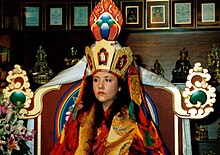Western tulku
This article is actively undergoing a major edit for a little while. To help avoid edit conflicts, please do not edit this page while this message is displayed. This page was last edited at 10:50, 31 October 2023 (UTC) (12 months ago) – this estimate is cached, . Please remove this template if this page hasn't been edited for a significant time. If you are the editor who added this template, please be sure to remove it or replace it with {{Under construction}} between editing sessions. |
| Part of a series on |
| Tibetan Buddhism |
|---|
 |

A Western tulku is the recognized successor to a lama or dharma master born in the West, commonly of non-Tibetan ethnic heritage.[1][2][3][4][5][6]
History
Foreign tulkus have been identified since at least the sixteenth century, when the grandson of the Mongol Altan Khan was recognized as the 4th Dalai Lama.[7]
Analysis and criticism
Tulku Bino Naksang has described the phenomena of Western tulkus as a "failed experiment" which did not account for the contradictions between traditional Tibetan culture and modern Western culture.[8]
The academic Abraham Zablocki uses the term "tulku envy" to describe a Western desire to "be[come] Tibetan" or inhabit a Tibetan body through the tulku system.[9] Zablocki analyzes The Mandala of Sherlock Holmes, by the Tibetan activist and author Jamyang Norbu, as a satire of this tulku envy, in an act of "counter-appropriation".[10]
List of Western tulkus
- Elijah Sacvan Ary
- Tenzin Ösel Hita
- Wyatt Arnold
- Jetsunma Ahkon Lhamo
References
- ^ John-Paul Flintoff (13 April 2012). "Did I know you in a past life?". the Guardian. Retrieved 30 October 2023.
- ^ Ary 2012, pp. 398–427.
- ^ Atay & D'Silva 2019, p. 222.
- ^ Moran 2004.
- ^ Bhushan, Garfield & Zablocki 2009.
- ^ "THE UNEXPECTED INCARNATION". Washington Post. Retrieved 31 October 2023.
- ^ Bhushan, Garfield & Zablocki 2009, p. 45.
- ^ Miller, Andrea (12 March 2021). "Magical Emanations: The Unexpected Lives of Western Tulkus". Lion's Roar. Retrieved 30 October 2023.
- ^ Bhushan, Garfield & Zablocki 2009, p. 43.
- ^ Bhushan, Garfield & Zablocki 2009, pp. 51–52.
Bibliography
- Ary, Elijah (2012-11-19). "The Westernization of Tulkus". Little Buddhas. Oxford University PressNew York. doi:10.1093/acprof:oso/9780199860265.003.0017. ISBN 0-19-994561-6.
- Atay, A.; D'Silva, M.U. (2019). Mediated Intercultural Communication in a Digital Age. Routledge Research in Communication Studies. Taylor & Francis. ISBN 978-1-351-39989-0. Retrieved 2023-10-31.
- Moran, Peter Kevin (2004). Buddhism Observed. London: Routledge. ISBN 978-0-415-32596-7.
- Bhushan, Nalini; Garfield, Jay L.; Zablocki, Abraham (2009). TransBuddhism. Amherst: Collaborations (Paperback). ISBN 978-1-55849-708-5.
